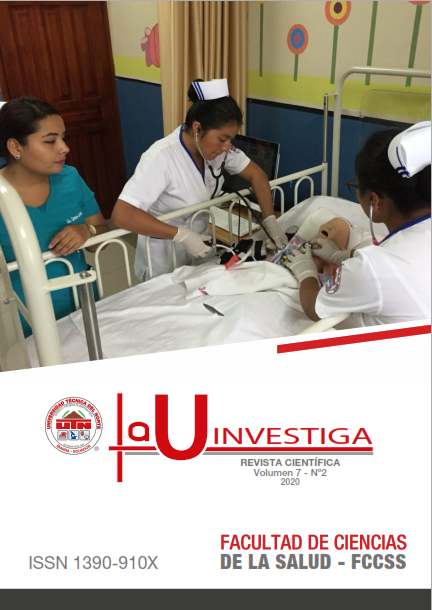Incontinencia Urinaria y su afectación en la Calidad de Vida, en centros geriátricos de la provincia de Imbabura
Urinary incontinence and its effect on quality of life, in geriatric centers of the Province of Imbabura
Keywords:
Urinary incontinence, Quality of life, PrevalenceAbstract
Urinary incontinence (UI) according to the International Incontinence Society (ICS) is defined as any involuntary loss of urine; This condition does not imply a vital risk for the patient, but it significantly deteriorates the quality of life of those who suffer from it, since it reduces their self-esteem and autonomy, being considered an important medical and social problem. The objective was to determine the prevalence of UI and its effect on the quality of life of those who suffer from it. The methodology of this study is descriptive, not experimental, cross-sectional, with a qualitative-quantitative and epidemiological approach. The study population was 299 elderly women who belong to Geriatric centers in the Province of Imbabura. Among the instruments, the IU International Consultation on Incontinence ICIQ-SF test and I-QOL quality of life test were applied. Through the results, a prevalence of urinary incontinence of 57%. Was determined, the most frequent being the stress urinary incontinence with 41%. The quality of life was found to be affected in 96% of the women with UI, the sub-scale of avoid and limit behavior being the most affected.
Downloads
References
J. E. Robles (2006) La incontinencia urinaria. Pamplona. Anales Sis San Navarra vol.29 no.2 http://scielo.isciii.es/scielo.php?script=sci_arttext&pid=S1137-66272006000300006.
Chang Calderón O, Pérez Rodríguez M, Figueredo Villa K, Llori Otero KM, Torres Pérez M, Torres Pérez M. Efectividad de la reeducación del suelo pélvico en adultas mayores con incontinencia urinaria de esfuerzo. Eff pelvic floor reeducation elder women with Stress Urin incontinence [Internet]. 2019;35(1):1– 14.Availablefrom:http://search.ebscohost.com/login.aspx?direct=true&db=a9h&AN=138196057 &site=ehost-live.
Finoli S, Goette M, Moran l. Incontinencia urinaria y sus repercusiones en la actividad sexual Área: Ciencias de la Salud. XXI Encuentro Jóvenes Investigadores la Univ Nac del Litoral [Internet]. 2017;4. Available from: http://web10.unl.edu.ar:8080/colecciones/bitstream/handle/123456789/8720/3. 1.4.pdf
Stemberg M, Parisotto D. Qualidade de Vida de Idosas com Incontinência Urinária. Rev Uniandrade [Internet]. 2018;19(1):45–52. Disponible en: https://uniandrade.br/revistauniandrade/index.php/revistauniandrade/article/view/630/886
Avery J, Stocks N. Urinary incontinence, depression and psychological factors - A review of population studies. Eur Med J Urol [Internet]. 2016;1(1):58–67. Disponible en: https://www.emjreviews.com/urology/article/urinary-incontinence-depression-and-psychosocial-factors-a-review-of-population-studies/
Kwon CS, Lee JH, Kwon CS, Lee JH. Prevalencia, factores de riesgo, calidad de vida y conductas de búsqueda de atención médica de la incontinencia urinaria femenina: resultados de la IV Encuesta Nacional de Examen de Salud y Nutrición de Corea VI (2007-2009). Int Neurourol J. 2014; 18 (1): 31-6.
Leirós-Rodríguez R, Romo-Pérez V, García-Soidán JL. Prevalencia de la incontinencia urinaria y su relación con el sedentarismo en España. Actas Urol Esp. 2017 Dec 1;41(10):624–30.
Cruz C, Linares M, Cruz A, Calero M. Incontinencia Urinaria en mujeres de Jaén: estudio de prevalencia. 2017 [cited 2020 Jan 15];vol.26. Available from: http://scielo.isciii.es/scielo.php?script=sci_arttext&pid=S1132-12962017000100006&lang=es
García Méndez A. Incontinencia urinaria y calidad de vida de las mujeres en una zona básica de salud. Enfermería Comunitaria [Internet]. 2017;5(4):61–70. Available from: file:///c:/users/hp/documents/downloads/dialnet-incontinenciaurinariaycalidaddevidadelasmujeresenu-6224484.pdf
Carreño LM, Angarita-Fonseca A, Pinto AL, Delgado AN, García LM. Calidad de vida relacionada con salud e incontinencia urinaria en mujeres con exceso de peso de Bucaramanga, Bucaramanga, Colomb. 2015;13(1):63–76.
Published
How to Cite
Issue
Section
License
Copyright (c) 2020 Cristian Santiago Torres Andrade, Katherine Geovanna Esparza Echeverría

This work is licensed under a Creative Commons Attribution-NonCommercial 4.0 International License.
The authors retain the copyright and guarantee the journal the right to be the first publication of the work as well as licensed under a Creative Commons Attribution-NonCommercial-ShareAlike 4.0 International License that allows others to share the work with an acknowledgment of the authorship of the work and the initial publication in this magazine. Authors may separately establish additional agreements for the non-exclusive distribution of the version of the work published in the journal (for example, placing it in an institutional repository or publishing it in a book), with an acknowledgment of its initial publication in this journal.

La U Investiga by La U Investiga is licensed under a Creative Commons Reconocimiento-NoComercial-CompartirIgual 4.0 Internacional License.You can find permissions beyond those granted with this license athttp://revistasojs.utn.edu.ec/index.php/lauinvestiga/index





